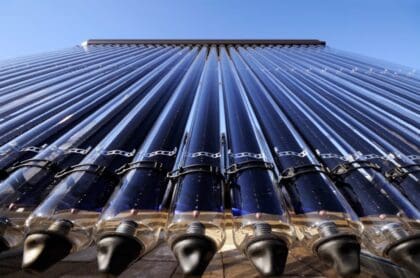
In the Government’s official response to its reform consultation, Energy Minister Baroness Neville-Rolfe confirmed the RHI will continue to support all four technologies currently supported by the scheme.
The 116-page statement included details of a fresh financing model and a number of tariff increases, including:
• The tariffs for new ASHPs and GSHPs will be increased to 10.02 pence per kilowatthour (p/kWh) and 19.55p/kWh respectively.
• All new ASHPs and GSHPs applying for support under the scheme will be required to have electricity metering to monitor their heating system. However, payments will continue to be on the basis of the deemed heating requirements of the property, except for second homes and where a renewable heating system is installed alongside another heating system, in which cases payments will continue to be on the basis of heat metering.
• GSHPs making use of a shared ground loop will continue to be eligible for the non-domestic scheme and will not be eligible on the domestic scheme.
• The tariff for new biomass installations will be increased to 6.44p/kWh, the level available between October and December 2015, adjusted for inflation.
• Heat demand limits will be introduced, to limit the level of annual heat demand in respect of which any household can receive support. The heat demand limits will be set at 20,000kWh for ASHPs, 25,000kWh for biomass boilers and stoves and 30,000kWh for GSHPs. However, this will not disqualify properties with higher heat demands from applying to the scheme. There will be no heat demand limit for solar thermal.
The tariffs stated in the response document are in 2016/17 prices and do not take account of any inflationary adjustments which will be made to tariffs on 1 April 2017.
The Government also intend to introduce the option for households to assign their rights to payments through the scheme to a third party. However, this will not be delivered alongside the spring 2017 reforms. The Government now intends that this will be implemented at a later date, to provide extra time to implement adequate consumer protection.
This reform will make way for new financing models to develop – for example, where a household receives a free or substantially reduced-cost heating system from a third party in return for assigning their rights to RHI payments to this third party.
The response confirmed: “For heat pumps, the reforms will support growth in the size of the market and improvements in the quality of the supply chain. There will be increases in support for domestic heat pumps, to support growing installation numbers over the next four years and beyond.”
The reforms also introduce a cap to the annual payments for new domestic biomass systems to make sure owners of larger properties are not overcompensated – there will be similar caps in place for new heat pumps. Alongside this, there will be a slight increase to the tariff for new domestic biomass systems, resetting the tariff at a previous level, to allow the technology to continue to deploy
The news that solar thermal would retain its subsidy support was welcomed by the Solar Trade Association (STA), which had mounted a concerted effort to oppose the initial proposals published last March.
The internationally proven technology will now remain in the RHI for domestic systems with no change from the current level of 19.74p/kWh of support over seven years. Applications of solar thermal in industry up to 200kW in size will also continue to be supported.
Paul Barwell, STA Chief Executive commented: “Solar thermal is back, which is great news for businesses and families who want to bring down their energy bills and do their bit to mitigate climate change. It is to the new Energy Department’s credit that they listened to the very strong arguments we made for retaining solar thermal within the RHI.”
The move reflects the robust case the STA put forward on the importance of solar thermal technology, which boasts even greater installed capacity globally than solar PV.
Retaining solar thermal will also help the fuel poverty alleviation agenda, as well as efforts to reach the Government’s own target of 12% renewable heat by 2020.
Solar thermal’s reinstatement in the RHI means there is a great opportunity for growth in a sector that already boasts some of the most advanced manufacturing in the world. With the RHI a typical business user will be able to earn back the cost of their installation within seven years; without the RHI it would have been 21 years, which would have prevented investment.
Isabella O’Dowd, Policy Analyst for the STA Solar Thermal Group commented: “The UK lags behind on solar thermal internationally but its potential in this country is huge. Solar thermal makes great financial sense for businesses and it is a low hassle choice for households with even limited roof space. Internationally solar thermal is used for space heating, community heating and industrial processes.
“Strategically solar thermal matters because while our homes and offices are becoming better insulated we will always need hot water and process heating. We might be a small industry with more limited applications today, but this technology has really tremendous growth potential.”
The solar thermal industry will breathe a sigh of relief after months of uncertainty over the decision. Consumers should also now have the confidence to invest in solar thermal, saving them money and energy in the long run, and reducing their carbon footprint. In addition a new EU labelling scheme for heating systems will enable customers to see clearly the benefits of installing solar thermal to allow them to reach the highest A+++ rating.